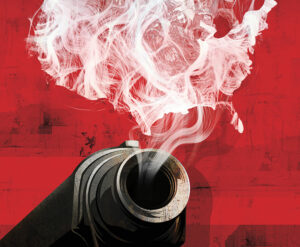Cool and comfortable this mid-day Thursday here in California’s Central Valley as apparently-obvious we’re into the autumn season — if only it stayed this way.
Winter, however, is now one day closer.
Dying in the US has taken a sizeable upswing the last couple of years, not only with the COVID pandemic, but we as Americans are murdering each other at a high rate, too.
Terrible data from the FBI’s annual account on crime, The Uniform Crime Report (to be released Monday), which shows a big-bump in murder of about 29-percent, way-knocking-off the previous one-year jump-rate — 12.7-percent in 1968. Although there was an increase in murders this summer, it looks to be less than the 2020 summer spike.
One odd point in the charts: Even as murder was up, however, overall crime was down — kill but don’t steal. And the killing wasn’t contained to one political side — Democrat/Republican kill rate the exact same:
Charts are hard. https://t.co/xyrlgoUZiT
— Carl Quintanilla (@carlquintanilla) September 23, 2021
A few reasons for this, but there’s no precedent at all — Jeff Asher, a crime analyst based in New Orleans, and co-founder of AH Datalytics, crunched the data at The New York Times, updated this morning, and the numbers are horrid — some snips:
Previously, the largest one-year increase in total number of murders was 1,938 in 1990.
The F.B.I. data shows almost 5,000 more murders last year than in 2019, for a total of around 21,500 (still below the particularly violent era of the early 1990s).The reasons for the rise may never be fully sorted out, but analysts have pointed to many possible contributing factors, including various pandemic stresses; increased distrust between the police and the public after the murder of George Floyd, including a pullback by the police in response to criticism; and increased firearm carrying.
About 77-percent of reported murders in 2020 were committed with a firearm, the highest share ever reported, up from 67-percent a decade ago.
The change in murder was widespread — a national phenomenon and not a regional one. Murder rose over 35-percent in cities with populations over 250,000 that reported full data.
It also rose over 40-percent in cities 100,000 to 250,000, and around 25-percent in cities under 25,000.No geographic area was spared. The F.B.I. reported in March that murder was up at least 20-percent in every region of the country, including around a 30-percent increase in the Midwest.
Overall, murder was up at least 20-percent in counties carried by Joseph R. Biden Jr. as well as by Donald J. Trump in 2020.One regional factor stayed consistent: Louisiana had the highest murder rate for the 32nd straight year.
Even with the rise in murders and a roughly 5-percent increase in violent crime, the new data shows that overall major crimes fell about 4-to-5-percent in 2020.
Murder, although it carries the highest societal cost, makes up a tiny portion of major crimes as defined by the F.B.I.
…
The evidence from big cities suggests murder is still up in 2021 relative to 2020, although the increase is not nearly as big.
My collection of data from 87 cities with publicly available year-to-date data shows murder up by 9.9-percent relative to comparable points in 2020.Some cities like Portland, Ore., and Las Vegas are seeing big increases relative to last year; some big cities like Chicago and New York are seeing flat numbers after sizable increases in 2020; and some places like St. Louis (which had the nation’s highest murder rate in 2020) are seeing sizable declines.
The first half of this year largely followed the pattern begun in the second half of last year.
The rate of increase in murder appears to be decelerating as more cities that had big increases starting last summer begin to report data for this summer.
No telling how many other aspects of life (and death) that COVID will make a hideous mark. Time will tell.
One major twist to the killing — America be gun country. A review last week on firearms and Americans from Pew Research, which found:
There are differences in gun ownership rates by political party affiliation, gender, geography and other factors. For instance, 44-percent of Republicans and Republican-leaning independents say they personally own a gun, compared with 20-percent of Democrats and Democratic leaners.
Men are more likely than women to say they own a gun (39-percent vs. 22%). And 41-percent of adults living in rural areas report owning a firearm, compared with about 29-percent of those living in the suburbs and two-in-ten living in cities.
Federal data suggests that gun sales have risen in recent years, particularly during the coronavirus pandemic.
In 2020, the number of monthly federal background checks for gun purchases was consistently at least 20-percent higher than in the same month in 2019, according to the FBI’s National Instant Criminal Background Check System.
The largest comparative percentage point difference occurred in July 2020 — when about 3.6 million background checks were completed, 44-percent more than were conducted in July 2019.
Of course, another factor is having ‘a’ gun, as opposed to owning an arsenal: ‘According to the Small Arms Survey of 2017, the United States had a population size of around 326,474,000 people. There were about 393 million firearms in the United States, meaning that there were far more guns than there are people.‘
How to cut down on all this fucking gun killing? Just make bullets way-super expensive:
And yet again, here we are…
 (Illustration out front by Taylor Callery, and found here).
(Illustration out front by Taylor Callery, and found here).